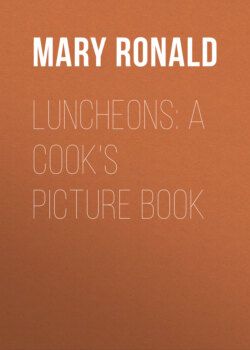Читать книгу Luncheons: A Cook's Picture Book - Mary Ronald - Страница 6
На сайте Литреса книга снята с продажи.
COLD DISHES
ОглавлениеTable of Contents
It has been said above that discrimination should be made in garnishing dishes; those to be served hot, for instance, should go directly from the fire to the table, and not be allowed to become cool while being elaborately garnished; on the other hand, cold dishes demand no haste and permit of so much elaboration that at suppers and buffet luncheons they are depended upon largely for table decoration.
The accomplished cook considers the work on cold pieces an opportunity for giving examples of his skill, and the ornamentation of molds and chaud-froids a kind of fancy work which requires nicety and taste. Under the head of cold dishes come all the salads, the pâtés, galantines, cold fish dishes, ices, and sweets. In each of these there is range in which to display culinary accomplishments. The skill requisite for moderate adornment of these dishes is not so great that one need hesitate to undertake them. Cold dishes are often more gratefully received in summer than hot ones, therefore it is desirable that every cook should be able to serve them in attractive forms. Again, from an economic point of view they are desirable, as meats can be served a second time in cold forms quite as acceptably as before.
Many meats, when served cold, require to be boned and pressed into good shape. Ordinary kitchen boards weighted down serve very well for a press. The meat, while hot, is put into molds, or is rolled in cloth, the ends tied, and then placed in the press. Small muffin-rings can be used for sweetbreads, bread-tins or oval molds for other meats. Chaud-froid sauce is often spread over galantines, and jellied mayonnaise over cold fish. On this smooth surface the decoration is laid in some design traced in fancy cuts of truffle, or in a combination of white of egg with truffles, cold tongue, olives, and other suitable things which give color. See illustration No. 114.
Aspic jelly is a principal reliance for covering cold pieces. It is not masking in this case, for the jelly should be perfectly transparent, while masking conceals the material of which the dish is composed. Aspic is also cut into small triangles or in squares to make borders, and is sometimes chopped and used for decoration. See illustration No. 3. Aspic is no longer one of the difficult preparations reserved for the hand of the very experienced cook. Any of the beef or chicken extracts stiffened with gelatine, and seasoned and cleared if necessary, make good aspic. The preparation is as simple as that of any jelly. A little care, however, in molding and handling is requisite for good results. Jellied vegetables are appropriate to use with jellied or other cold meats. Small cups are used for molding them, and the pieces can be made very ornamental. See illustration No. 6. The small forms placed around meat and served with a green salad make an attractive cold course.
NO. 7. FANCY SKEWERS FOR GARNISHING COLD MEAT OR FISH DISHES.
1. Mushroom, Cranberry, or Olive, whole Hard Boiled Egg, Cranberry, Mushroom.
2. Cranberry or Olive. Prawn, Quarter of Lemon. Prawn, Cranberry, or Olive.
3. Mushroom with Stem. Notched Slice of Lemon. Cranberry or Olive. Lemon, Cranberry, or Olive.
Fancy skewers are much employed on cold meats. Their office is purely ornamental, so when they are used trouble is not to be considered. A fancy-headed skewer is run through, perhaps, a fine red cockscomb, then a truffle, then a fancy cut of lemon, or a mushroom, or a carved vegetable. Truffles in combination with vegetables molded in aspic and quenelles also are often used. If all these things are impracticable, one can devise combinations more easily obtained. A trussing needle can be utilized, concealing the head in a section of lemon and building down with carrot and turnip in alternating colors and shapes, and perhaps using a crawfish, an egg, or an olive in the combination. See illustration No. 7. French authors recommend that these skewers be employed only occasionally, so that they may not lose the attraction which novelty gives them.
Cracked, crushed, or ground ice can often be used with good effect. It gives crispness to olives, celery, radishes, and cucumbers, and enhances the beauty of the dish as well. With raw oysters it is indispensable, and with melons very desirable. A free use of ice on the summer breakfast table will go far toward inviting an appetite for that meal.
It is well to remember that although great elaboration is possible in cold dishes, it is not necessary, and dishes can be made very attractive without chaud-froid, aspic, or traced designs. If the pieces are shapely, they will look well if simply sprinkled with chopped parsley, chopped white of egg, or the crumbed yolks, and dressed with any of the green salads. Flowers also can be used to aid in adornment.
NO. 8. BOILED FISH IN SWIMMING POSITION.
